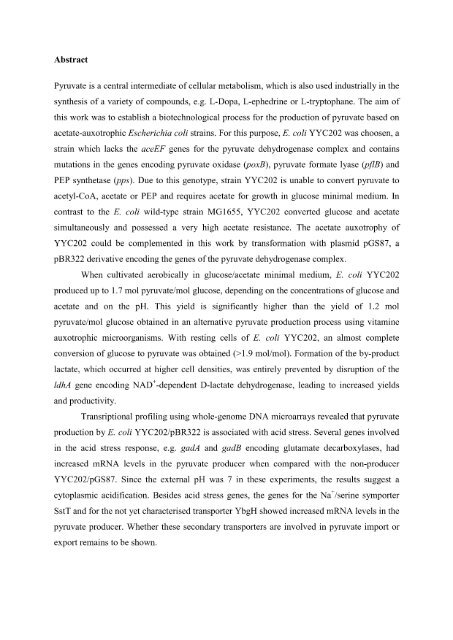Pyruvat-Produktion durch acetatauxotrophe - JUWEL ...
Pyruvat-Produktion durch acetatauxotrophe - JUWEL ...
Pyruvat-Produktion durch acetatauxotrophe - JUWEL ...
Erfolgreiche ePaper selbst erstellen
Machen Sie aus Ihren PDF Publikationen ein blätterbares Flipbook mit unserer einzigartigen Google optimierten e-Paper Software.
Abstract<br />
<strong>Pyruvat</strong>e is a central intermediate of cellular metabolism, which is also used industrially in the<br />
synthesis of a variety of compounds, e .g . L-Dopa, L-ephedrine or L-tryptophane . The aim of<br />
this work was to establish a biotechnological process for the production of pyruvate based on<br />
acetate-auxotrophic Escherichia coli strains . For this purpose, E . coli YYC202 was choosen, a<br />
strain which lacks the aceEF genes for the pyruvate dehydrogenase complex and contains<br />
mutations in the genes encoding pyruvate oxidase (poxB), pyruvate formate lyase (pfB) and<br />
PEP synthetase (pps) . Due to this genotype, strain YYC202 is unable to convert pyruvate to<br />
acetyl-CoA, acetate or PEP and requires acetate for growth in glucose minimal medium . In<br />
contrast to the E . coli wild-type strain MG1655, YYC202 converted glucose and acetate<br />
simultaneously and possessed a very high acetate resistance . The acetate auxotrophy of<br />
YYC202 could be complemented in this work by transformation with plasmid pGS87, a<br />
pBR322 derivative encoding the genes of the pyruvate dehydrogenase complex .<br />
When cultivated aerobically in glucose/acetate minimal medium, E. coli YYC202<br />
produced up to 1 .7 mol pyruvate/mol glucose, depending on the concentrations of glucose and<br />
acetate and on the pH . This yield is significantly higher than the yield of 1 .2 mol<br />
pyruvate/mol glucose obtained in an alternative pyruvate production process using vitamine<br />
auxotrophic microorganisms . With resting cells of E. coli YYC202, an almost complete<br />
conversion of glucose to pyruvate was obtained (>1 .9 mol/mol) . Formation of the by-product<br />
lactate, which occurred at higher cell densities, was entirely prevented by disruption of the<br />
ldhA gene encoding NAD+-dependent D-lactate dehydrogenase, leading to increased yields<br />
and productivity .<br />
Transriptional profiling using whole-genome DNA microarrays revealed that pyruvate<br />
production by E. coli YYC202/pBR322 is associated with acid stress . Several genes involved<br />
in the acid stress response, e .g . gadA and gadB encoding glutamate decarboxylases, had<br />
increased mRNA levels in the pyruvate producer when compared with the non-producer<br />
YYC202/pGS87 . Since the external pH was 7 in these experiments, the results suggest a<br />
cytoplasmic acidification . Besides acid stress genes, the genes for the Na+/serine symporter<br />
SstT and for the not yet characterised transporter YbgH showed increasedmRNA levels in the<br />
pyruvate producer . Whether these secondary transporters are involved in pyruvate import or<br />
export remains to be shown .

















